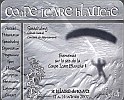|
The terms "Speedriding" and "Speedflying" are often used
interchangeably, but it makes much sense to distinguish the style within the
range of small wings: Some are thought
strictly for skiing (riding) use and they
are specifically designed for a low glide-ratio (controlled by trimmers), so the
skis stay close to the ground.
Other wings have a better glide-ratio and can be foot-launched even in nil-wind
conditions, but the pilot is
rather 'flying over' than 'riding on' the ground. These wings are also very
interesting for mountaineers
as they
are very light (some less than 2.5kg) and allow descends even in stronger
winds, and they can be flown without a reserve, saving even more weight.
If you're unsure whether this is a sport for you, you can read this very good
post in the
PG-Forum by Paul. I think it gives a lot of truths about the risks involved
and the mindset you should have. This webpage gives an overview of the speedy wings on the market as of
January '07.
If you have news /
corrections
to my page: Please send me a
mail!
General Speedflying
Websites:
-
NoGravity.ch
: Daniel Kalberer has written great articles on
Speedriding and a
Test of Nano & Hellracer which was published in a shorter version in
Gleitschirm-Magazin.
-
Speed-Flying.com:
The Swiss speedflyers: only Gin-Nano focused unfortunately...
-
Thermik.net : These guys
have fun with some Gin Nanos and even try a summer-launch
-
speedriding.canalblog.com: French website with news on the topic
Videos:
Forums
If you watch the videos linked above, you might get the
impression that flying mini-wings is a very dangerous sport, more dangerous
than the big, regular paragliders. But in fact, if a few points are taken
into account, flying the minis can be safer than the regular ones. With
paragliders, there are usually 3 situations that are more dangerous: 1)
start 2) collapses 3) landing. Due do the high wing loading and
the much more tolerant wing profile, collapses are virtually unknown when
flying miniwings unless you use them in horrible wind-conditions. Even if
provoked, a collapse would open fast without much disturbance. So if you
start and land on skis, stay away from the terrain during the flight and
work a bit on your landing technique, then you could try one of these
mini-wings with a relatively low risk (but still with great fun!)
The problems only begin when you go from Speedflying (staying above the
ground) to Speedriding (Touch and Go's with your skis) as very good judgment
is needed how your glide path will come out, wether you will make it over
that rock or tree or wether you might hit the ground in a curve etc.
Great caution and discipline is necessary: you should learn to know your
wing step-by-step, before you start to touch the ground more often.
Footstarting mini-wings
The other thing I found rather difficult is footstarts (groundlaunching)
in low-wind conditions. Without the skis you cannot just run fast enough
for a start like before. Now the timing has to be very exact or you are
bound to hit the ground at real high speed while running. Note that you
should not attempt to footstart the real Speedride wings with a
glide-ratio lower than ~5.
From the list above the Nervures Swoop, Bio-Air Skim and Swing Speedy
are the Speedflyers that are suitable for foot-starts. The
manufacturers of the others even write in their manual that footstarts
should not be attempted!
The following tips cannot and should not replace a proper 'live'
training by a good instructor.
Most manufacturers sell their wings only to people that have passed a
formal training on their
speedriders and there is already initiatives underway to get an
independent certification for your
skills after such a training. Nevertheless it cannot hurt to prepare
your mind for what you can expect before visiting such a training.
Speedriding with skis and a larger Speedrider (~14m²) is a good & safe
way to learn. If you don't
have the chance to learn in the snow, there is a couple of things that
you should keep in mind before trying a foot-launch with these small
wings: (Foot-Launch should only be tried with wings
that have a better glide-ratio (~1:5), on the list above maybe down to
the Ski'M)
- For the start, you usually close the trimmers (be
careful, some
wing have a tendency to fall down behind you while running, if the
trimmers are closed to far and you add a little break!).
Start: walk (wind) or run (no-wind) with the A-Lines in your hand,
then pull the brakes ~50% shortly and feel the caps position above you.
Reverse starts are also possible. Now comes the acceleration phase:
In low-wind conditions, good timing is critical: You have to develop
a feeling for how much brake the wing wants. Usually these
mini-wings like to run very freely ahead during the acceleration
phase, and right when you feel that it develops good lift, you
should add some brake to be lifted away. This can
require as little as 3 quick steps and you are airborne.
- Important: Once you left the ground, release the brakes
slowly or you'll dive right back into the ground,
(unless the takeoff is really steep)!
- For the first flights while playing in the air it is best to
leave the trimmers in a rather closed position. Later you can open
them, but be prepared that the behavior to go into curves changes a
bit.
- Most of these wings are extremely agile! They react very sensitive to brake input and
weight-shift! For your first flights remember: If the roll
(left-right swinging) starts to get too much without
intention, then do not try to correct it actively as you will
only make it worse! Breathe deeply, hold both brakes at ~30% and
wait! I did this by holding on with my hands to the risers.
- For landing, check in the manual if you should open
or close the trimmers.
The Swoop likes open trimmers for example, as you need the speed
to flare out.
You approach in a straight line, and you will see the ground approach quickly with
a ~1:3
glide at a speed of 65Km/h...Sounds scaring? It is scaring
the first time!
But resist the urge to pull the brakes too
early (!!!) as you need that speed to flare.
When you are only
~2-3m high, gradually pull the brakes so your sink stops and
you
just go level over the ground. Don't pull more than that or you
will go up again and have
a tough fall at the end. When you feel
that almost all the energy is used up, pull the final
brake-range to
stall the wing. This should leave you with a still-standing landing
(or just a
few steps).
Later, you can also try to make a slight turn (90degree) into the
landing field just before the
landing, to add even more more speed and allow longer flairs (fun!).
After you gain some
experience with the amount of altitude you loose with such a turn
(~20 Landings), you can
also try to do a "Hook-Turn" of 180 degrees to allow longer flairs.
Note, that this is a
dangerous game if you miscalculate the height. Better not to
experiment with these turns too early!
It takes some discipline to remember 2) 4) and 5) in the
real-life experience, as your instincts might want to tell you
otherwise. Better trust your discipline in this case and not your
instincts! ;-)
The feeling in flight is awesome: The air is rushing around you
and the lines begin to sing. Curves can be varied from gentle turns (weight
completely on the outside) to fast (weight neutral) or
superfast-hooks (weight + brake). The first variant is suitable
for soaring without loosing too much altitude. On sharper turns, you
will dive down and get lower quickly.A 360 curve turns into a spiral
quickly, but the forces on your body are much gentler than on a wing
with long lines.
I was a bit afraid when the first thermals of the day caused some
turbulences, as the wing dashes back&forth, left&rigth quickly when flying
at trimspeed. Putting on some brake as in 4) will calm it down a bit, but if
you have enough altitude, adding speed by doing some curves / turns will
make it really stable.
Places to go Speedriding
In general, you shouldn't do Speedriding on slopes where normal Skiers
are skiing.
The damage to the sports reputation would be horrible, if a skier would get
hurt by a Speedrider.
So look for areas that are ideally off-piste (powder-snow) in order to not
hassle the skiers.
Skiing Resorts that specifically allow speedriding and/or have special areas for
that:
- Val Fréjus (FR),
- Val Thorens (FR),
- les Sept Laux (FR)
- Verbier (CH)
Skiing Resorts that seem to tolerate Speedriding:
- Tignes (FR)
- St Hilare du Touvet (FR) (yes, there's a
little ski resort there too).
History
As said in the intro, the sport of speedriding is not new, just the name & popularity is new!
Skydivers have been starting their wings on the hills for many years calling
that "ground-launching" Here you can find a nice summary of the history:
www.nzaerosports.com
Related Sports:
|
|
| Nova Shockwave
(formerly
known as Racewing)
-> Goto Top |
| |
|
| Website: |
http://nova-wings.com |
| Sizes: |
12m² (projected = ~14
flat) |
| Price: |
|
|
Character: |
This is
not a Speedriding
glider as the term is normally used!
It is a special wing for
extreme competitions where
fast descent combined with an acceptable glide-angle to a goal is the main challenge.
It excels at this with a 8:1 glide at trimspeeds of 55 and max speed of
~95Km/h. |
| |
|
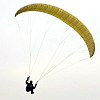

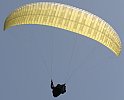


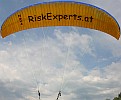
Manufacturers Info
Hannes Papesh writes on the Nova Website:
Christian asked us to develop a special wing for the
The Red Bull
Dolomiten Mann. For this type of race it should be small, light, good to
launch and of course very fast with
still having performance (l/d around 8). I was quite lucky with my first layout.
It hit the target and even exceeded our expectations. The first proto (12sqm
projected) had strong lines to be on the safe side in all tests but already
showed very impressive performance and speeds. It was very easy to read a 3
digits speed on the GPS. Mario (105kg) got 95km/h horizontal speed (no wind)!
Now the final version is thin lined, performance optimized and even faster
(final measurements will follow).
During the first flights even our experienced test pilot Mario Eder got thrilled
and suffered from an "adrenaline overdose" during the flights with that bullet
(trim speed 55km/h). In the meanwhile this wing demonstrated it's suitability
for everyday flying. Chri flew it on the dune: often the others could not launch
cause of the strong winds. But even in light winds, Chri had surprisingly nearly
no disadvantage. We also didn't expect that it will be possible to launch with
12sqm at 10-15km/h backwards wind: it is! Chris was thermalling in soft and
strong conditions and even did some test maneuvers without troubles.
We're planning to build this wing in series: only for very good pilots and of
course no DHV certification!
:-)
Comments
Although it's super fast (apparently 55km/h trim and 95km/h
accelerated!) it probably wouldn't make a great speed riding wing
because the glide is far too good.
A speed riding wing is designed to be fast, yes, but to also give you a
choice of poor glide angles, typically from 2:1 to 5:1 depending on the
amount of brake. The idea is to remain close to the hill, carving your
skis through the snow or dragging a wingtip on the ground. An 8:1 glide
would make it very hard to stay close to the ground especially in
mountainous terrain.
Related Links:
| UTURN Speedmaster
-> Goto Top |
| |
|
| Website: |
http://www.u-turn.de |
| Sizes: |
15m² |
| Price: |
|
|
Character: |
This is
not a Speedriding
glider as the term is normally used!
It is a special wing for extreme
competitions where fast descent combined with an acceptable glide-angle
to a goal is the main challenge. |
| |
|

Manufacturers Info
With immediate effect the ultimate speed-machine is available from
U-Turn: The FREE FORCE 15 SPEEDMASTER will lead experienced pilots into an
new dimension of speed-gliding.
The U-Turn management came to the decison to manufacture the SPEEDMASTER in
series after it became clear that a rapidly growing number of organisers
include speed-paragliding into their multi-discipline competitions. The
canopy, 1:1 downsized of the DHV-certificated dimensons FREE FORCE 22, 24
and 26, passed now its big practical test: Christian Amon won with a FREE
FORCE 15 SPEEDMASTER the race of the professional pilots at the
Dolomiten-Man 2005 in Lienz, while Christian Gruber ranked first in the
amateur class.
Especially the gliding ability of the canopy even at high speed impresses
the pilots. Designer Ernst Strobl is very happy about the performance, too.
He points out: „The FREE FORCE 15 SPEEDMASTER is an uncompromising canopy
that never will be suitable for a DHV-certification. We recommend this
glider only for professional or very experienced pilots.” Therefore U-Turn
will sell the SPEEDMASTER only to very skilled pilots, as U-Turn does it
already with its acro-glider-reference G-FORCE.
Comments
As said in the overview above: This is a special wing for fast flying in
special competitions,
not a speedrider. But there are rumors that Ernst Strobel is already working
intensively on
some real Speedrider protos...
| WOC Velocity
-> Goto Top |
| |
|
| Website: |
www.wings-of-change.at |
| Sizes: |
6 & 8
m² |
| Price: |
|
|
Character: |
This is
not a Speedriding
glider as the term is normally used!
It is a special wing for extreme acrobatics and fast show flying. |
| |
|

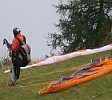
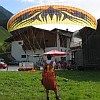
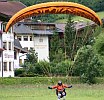

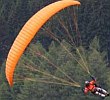
Data
| Size |
|
6
|
8
|
| Flat-Area |
m²
|
5,99
|
8,2
|
| Projected-Area |
m²
|
5,53
|
6,72
|
| Flat-Span |
m
|
5,74
|
6,72
|
| Projected-Span |
m
|
5,41
|
6,32
|
| Flat Aspect Ratio |
A/R
|
5,77
|
5,77
|
| Projected Aspect Ratio |
A/R
|
4,72
|
4,72
|
| Trimm Speed |
km/h
|
72-78
|
65-70
|
| Top Speed |
km/h
|
;-)
|
;-)
|
| Number of cells |
|
44
|
44
|
| Glider weight |
kg
|
2,5
|
2,7
|
| Weight Range-min. |
kg
|
25
|
35
|
| Weight Range-max. |
kg
|
35
|
45
|
Manufacturers Info
None found
Comments
These 2 wings look like the most extreme in size and specifications.
They are acro-wings and not Speedriders and will probably not be
very usable when misused as speedriders for staying close to a
slope. Foot-start will most likely only be possible in a good headwind.
| Nervures:
Swoop
-> Goto Top |
| |
|
| Website: |
French:
http://www.nervures.com
(<- more up to date)
English:
http://www.nervures.co.uk |
| Sizes: |
10m²
(fast speedriding for experts)
14m² (slower Speedflying and
mountaineering-footlaunch-descents)
16m²
("Summer-Swoop": Footlaunch & Speedfly-beginners ) (all
m²
flat) |
| Price: |
1600-2000 Euro |
| Character: |
The 14 & 16 Swoop are a bit larger than the other, faster speed riding wings and
are aimed
at a different style of speed riding, more flying close to, than skiing on
the
ground. It's also a good way to get into speedflying with max safety. They have the advantage of being foot-launchable even in a slow tailwind (i.e. you don't need skis) so you get a walk-up / swoop-down package
weighing
~ 2.7kg for the wing, bag and
harness! Summer hikes are now a delight! |
| |
|

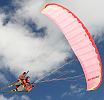
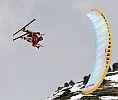



My own pictures:



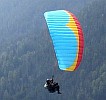
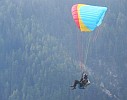
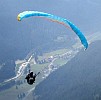
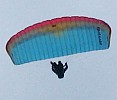

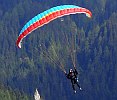
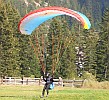
Data
| Model |
Swoop 10 |
Swoop 14 |
Swoop 14
montagne |
Swoop 16 |
Swoop 16
montagne |
| Area (flat) |
10m² |
14m² |
14m² |
16m² |
16m² |
| Cells |
28 |
28 |
28 |
32 |
32 |
| Aspect Ratio |
3.4 |
3.4 |
3.4 |
3.75 |
3.75 |
|
Speed Trimmers closed
|
65 |
56 |
56 |
nc |
nc |
| Speed Trimmers open |
75 |
66 |
66 |
nc |
nc |
| Weight (kg) |
2.26 |
2.86 |
2.08 |
3.3 |
2.45 |
Manufacturers info
The theory might look simple but the reality is a lot more complex: we
wanted a good glide to be able to fly above shallow slopes, trees etc.
Moreover the good glide had to allow for foot launch and landing. We had to
abandon the idea of copying or adapting skydiving parachutes because of
their lack of performance.
We quickly realised that even though it is easy to design a mini-wing with
an acceptable glide, it is much more difficult to make it resistant to
turbulence. On the top of that the mini-wing had to have a sound behaviour
on diving trajectories when it is set to a very low angle of attack.
We had to build several prototypes to find the right airfoils. In the end,
using our experience gained with the design of the “performance parachute”,
we got the “SWOOP”.
The usability is very high: with the 14 and the 16m² wing, it is easy to
foot launch and land in null wind. With the 10m² it is bit more demanding,
but still possible. As soon as the trims are off, the wing accelerates, the
trajectory dives and you enter the world of speed flying.
The structured airfoil (use of diagonal ribs) and high tension cloth give
the wing speed and acceleration qualities very different from those of a sky
diving parachute. The glide at landing is superb and allows endless flairs
without the need of a hook turn. This greatly increases safety as you can
land on foot on hardcore surfaces after a long approach in a straight line
without having to bank hard before.
Our main concern has been to make this wing as resistant to collapses as
possible. The Swoop is very solid in turbulence. Trimmers off, it is
perfectly fitted for the practice of “Speed Flying” and to give you the
freedom of limitless radical maneuvres.
Personal Comments
Nervures is mostly unknown in the DHV-test-mandatory sphere of Germany
and Austria. Even alpinists in the paragliding community don't know much
about these experts in lightweight mountaineering wings. I was surprized to
see a speedrider on their webpage last winter and the concept appealed to me
most of all the wings I had seen until then: Their wing can be used as a
multitalent for
- Speedriding with skis
- Superlightweight Mountaineering in summer
- Soaring in strong winds when everyone else packs and goes home.
I got a test-Swoop in size 14 from Manu Bonte in Oct.06 (thanks a
lot!) was really amazed by the first flights already! Take-off and
landing were the parts that I was concerned most before, but
both proved to be rather easy in the end with a little advice from Manu.
Additionally to what I have written in the general section
the Swoop likes. The trims closed almost completely to about ~90%. If
you close the trimmers all the way, the wing has a tendency to fall down
behind you. I have yet to try the swoop in winter with skis, but I
already feel that the 14 is designed more
for flying close to the ground with an occasional touch&go. This can also be
seen in the videos
on the Nervures homepage. The Summer-Swoop 16 superlight seems to me
to be the perfect mountaineering wing!
Related Links:
| Swing Speedy
-> Goto Top |
| |
|
| Website: |
http://www.swing.de |
| Sizes: |
~11.5m² flat |
| Price: |
|
|
Character: |
Fast and very agile wing,
great for foot-launches and Speedflying!
Not ideal for beginners, but lots of fun for the advanced pilot. |
| |
|
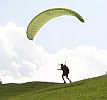

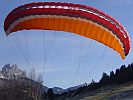
Data
| Area (flat) |
11.5 |
| Aspect ratio (flat) |
3.5 |
| Number of cells |
26 |
| Wing weight |
2.7 |
| Risers |
4 |
Manufacturers info:
Not yet public on the Swing web-pages - send a mail to me if interested!
Comments
A very agile wing more suited to the advanced Speedflyer. The wing comes
up quickly on starts and gives very good feedback so it is one of the best
wings
for foot-starts, despite its small size.
The agility is the highest of all the wings on this page: minimal
brake-input is needed to get the wing from all the way left of you to all
the way right of you. But oing this, the wing reacts very precise and
therefore it is like carving in the air when you descend the hills in
wing-over style.
This wing gives me the most fun when just speedflying. Landing is easy, but
again beginners should take care not to stall the wing pulling too far on
the brakes.
Related Links
| Bio-Air Ski'M
-> Goto Top |
| |
|
| Website: |
http://www.bio-air-technologies.com |
| Sizes: |
12m² flat (9.3 projected) now also 15m² |
| Price: |
1300€
|
|
Character: |
Note that this
wing has a very good glide ratio, matching the one of the Swoop and the
Speedy above (
= good for foot-launches), but it has a device that allows it to
reduce it's glide-ratio, to match the one of the Speedriders. Besides
this it is a fast & agile wing, but still offering relatively long
brake-range! It flies like a small paraglider and the manufacturer also
recommends it for training of beginners in the sport of paragliding (but
only running down the hill) |
| |
|
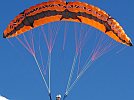
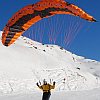



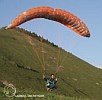
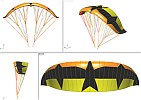

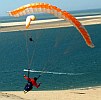
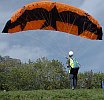
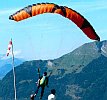

Data
| Size |
12 |
|
Speed minimal |
< 30Km/h |
| Area projected |
9.30 |
|
Speed trims on
|
50Km/h |
| Area (flat) |
12.00 |
|
Speed trims off
|
67Km/h |
| Wingspan (flat) |
7.30 |
|
Best sink rate |
2.5 |
| Aspect ratio (flat) |
4.4 |
|
Glide ratio |
5 down to 1! |
| Number of cells |
28 |
|
Price |
1000
€ |
| Wing weight |
2.8 |
|
Material |
Porcher |
| Flying weight |
60-100 |
|
Colour scheme |
Orange-Noir |
| Speed mini |
30 |
|
Lines |
2A-2B-2C |
Find more on the detailed Excel Sheet with
Polars etc!
Manufacturers info:
The Ski'M is the first wing derived from a common effort between Olivier,
Etienne and Laurent. "We wanted a 'speed-riding' wing which is foot-launchable.
"
The decision to create this wing was taken end of December 2005. April 20
2006, the protos arrived in France and the 1st flight was done at Cluses on
the 22 of April by Laurent. Later, Pilou did the first flight over snow at
the Arcs. Today the Ski'M offers a large usage potential thanks to large
amplitude brake inputs. From the beginner to the advanced pilot, the wing
pleased those who tried it. It has been tested in the following
fields:
- groundhandling (learning to kite in strong wind)
- speed-riding
- speed-flying
- acro
- mountain flight (descents after
The Ski'M is now sold for 1300€ all taxes included, plus shipping.
This price includes the wing, a protective bag and the "central command":
The 'central-command' is a middle line that pulls down the center of the
wing, and increase sink rate and speed. It is same as on the bigger Bio-Air
wings (used as a big-ears replacement there) but on the Ski'M it is an ideal
device for speed riding with skis. Bio-Air says for ski-Speedriding a
glide-ratio of 2,5 is a maximum. With the central-command middle-line the
glide ratio of the Ski'm can be adapted down to 1!
|
Comments
The folks with the Bionic Wings now also have a hot Speedflyer: the Ski'M
Olivier Caldara (the designer) gets really excited about it in a
Paraglidingforum.com-thread
and explains the impressive features. It is not designed as a wing for
experts only, but
for a larger audience from beginner to expert. The brake range is much wider
(60cm) than
usual on these small wings, which makes the steering & landing easier for
beginners.
The feature that really makes it special (besides the cool design) is the Central-Command line which
makes the wing a multil-purpose tool, as foot-launch (requires high glide-ratio) and
Ski-Speedride (requires low glide-ratio) can normally not be fulfilled by
the same wing.
The wing flies almost like a normal paraglider only with much higher
speed and more sink.
The rolling tendency of the other speedflyers has been damped nicely to a
good level here!
An absolute recommendation!
Related Links
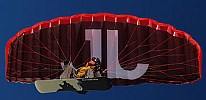
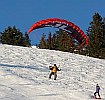
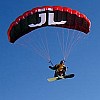
Data
| Area (flat) |
12.8 |
| Wingspan (flat) |
6.8 |
| Aspect ratio (flat) |
3.6 |
| Number of cells |
22 |
| Wing weight |
<3kg |
| Flying weight |
|
| Speed mini |
25 |
| Speed max |
70 |
| Lines Length |
3,05m |
Manufacturers info
September 2005 we first saw speedriding on the DVD of AcroFolies.
Instantly thrilled we made ourselves on the construction of such a
glider - jumped any time-related, organizational and other wattles and
now we have it! After sensational 4 months of development: our JN &
Profly speedrider: the HELLRACER.
The HELLRACER is different ...
... it not a small paraglider
... not a skydiving canopy
... and also not a kite
but a real
Speedrider!
independent designed profile Special features:
optimized outline -
with the brake the rider can adjust the flying speed. He can adapt the
glide path to the steepness of the hill. On demand the HELLRACER rides
or flies.
closed cells on the outer wing for precise handling - the
HELLRACER is easy to take off and easy to land. The brake range is so
wide that a non desired full stall is nearly impossible.
proved
materials -the specially harness is very light and comfortable that you
can use it also for long flights with a paraglider.
DHV load test up
to 8g
The HELLRACER is a combination of parachute and paraglider
The
HELLRACER is different: it’s not a small paraglider, not a skydiving
canopy and not a kite. Designed for high speed with extreme stability
and a wide flying speed range. Featured with a special, very stable
airfoil, high tenacity materials and a - for this use - optimized
design.
First there were skydiving canopies, now come mini
paragliders?
The first speedriders used old skydiving canopies. Now -
since the spark also jumped to the paragliding scene - also downsized
paragliders are used sometimes. One can be anxious to the further
development of this sport or the development goes to.
For us both -
parachutes as well as downsized paragliders - have considerable
drawbacks. That's why we're gone our own way and optimized the benefits
of parachute and paraglider in our speedrider kite.
The HELLRACER
is designed for speedriding on snow ...
it works well with snowboard
and ski. But you don't need to wait for snow, you can use the HELLRACER
for wagas on dunes, for ground handling and if you are a professional
pilot as well for parashending.
Our 20 years experience with
skydiving, kite and paraglider design guarantees a very safe, well
optimized glider and harness bundle for maximum fun. Try it! |
This glider is very similar to the J/N Hellracer.
It uses different material and design.
Personal Comments
I liked this Speedrider the moment I pulled it up behind me from a bundle
in a tailwind: The canopy pops open with ease and off you go. But not off
into the air for the beginning: Unlilke the speedgliders described above,
the WoC sticks to the ground even in steep terrain until you pull the brakes
and tell it to take off by that. This is the ideal behavior for a speedrider
and the WoC is probably still the best all-around package for Speedriding
(as opposed to Speedflying over ground) The long brake-range makes
it easy for beginners to learn, without being punished for an abrupt
unintentional pull on the handles. The glider is quite stable which is nice
when you touch the snow with one ski first, because it doesn't misinterpret
this as weightshift. The provided harness works quite well. A difference to
the other gliders are the missing trimmers which are here replaced by small
T-Handles on the A-risers: Pull one and the wing accellerates in that
direction, loosing more height. Easy enough concept, known from the
Skydivers.


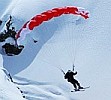


Manufacturers info
NIVIUK Gliders is ready to offer you quality material for
this new discipline. NIVIUK Gliders has developed a Speed Riding glider,
the “NOOKY” in three sizes…NOOKY means “power”, “having guts” in Inuit…
this gliders is characterized by its great range of speed and an
astonishing maneuverability.
@@@ more on webpage now - update!
The Video:
Speed Riding NIVIUK .wmv [29.9 Mo]
Personal Comments
The Video is one of the best I've seen so far!
Very impressive how they soar and even use the wing as a kite to go uphill!
@@@ Tested the wing now -> more to come soon...
Related Links:
| Ozone Bullet
-> Goto Top |
| |
|
| Website: |
http://www.flyozone.com |
| Sizes: |
10m²,
12m², 14m²
|
| Price: |
Nov. 2006 |
|
Character: |
Definitely a very fast wing
designed for Ski-launch only! |
| |
|
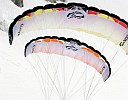
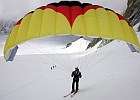
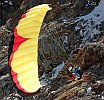
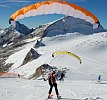
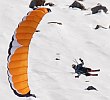

Data
| Model |
100 |
122 |
144 |
Materials :
|
| Flat area (m2) |
10 |
12.1 |
14 |
| Proj area (m2) |
8,9 |
10,6 |
12,4 |
| Proj AR (m) |
2,8 |
2,8 |
2,8 |
| Flat AR (m) |
3,49 |
3,49 |
3,49 |
| Flat span (m) |
5.9 |
6.4 |
6.9 |
| Proj span (m) |
5 |
5.5 |
5.9 |
| Root chord (m) |
2 |
2.2 |
2.3 |
| Cells |
18 |
18 |
18 |
| Weight (kg) |
2.2 |
2.5 |
2.8 |
Manufacturers info
From the website
Is it SpeedRiding or SpeedFlying? We're still not sure. What we do know
is that we have one, and we like it a lot.
The Bullet is still in the final prototype phase, but we can tell you
that it will be available in 3 sizes: 100, 122, and 144, which roughly
translate to 10m2, 12m2, and 14m2. The Bullet is designed to be a true
SpeedRiding/Flying wing with a very fast trim speed and a steep glide
angle, ideal for flying low and fast on snow in the mountains this
winter.
The Bullet will be available in all 3 sizes in November, and will be
sold with a specially designed Harness.
We'll send more info soon so please resist the urge to email us with
questions about the Bullet, at the present time we can't tell you any
more about this project than we have right here- it's classified!
Press Release (Mid November 2006)
Hi Everyone
We’ve had a lot of inquiries about the Bullet, so although it is not yet
finished we wanted to send out some info on it because we know that
people must be asking you as well.
At the moment Rob and I are in Austria finishing up the trimming and
finalizing the design of the wing. The technical specs of the final
version are attached. Read below for more information on its design and
features. Please keep in mind that this is just a preview, and the
release date is completely dependent on the glider and harness being
finished to our satisfaction. We hope that it may be orderable by late
November or early December.
Our PhilosophySpeed-flying is a completely new sport and
therefore we must understand that everyone practicing it this year is a
beginner. For this reason, we have striven to make the Bullet as
accessible and enjoyable as possible for the new pilots who will be
taking up the sport this year. During the course of our testing, we
realized that our first prototypes and the current wings on the market
for speed-flying fell short of what we considered to be acceptable in
terms of ease of use and comfort. Because these wings are so small and
so dynamic, total beginners found it difficult to be confident with the
high speed and dynamic handling that is inherent in the nature of these
wings. As a result of this, we have designed the Bullet to be safe and
easy to use in all respects. We are not at all interested in pushing the
limits of performance and speed in this sport, as we see this leading in
the wrong direction and potentially to the failure of the sport.
The Wing
- Easy launch. This is imperative for new speed-flyers, and
the sometimes difficult launching conditions that can be experienced
in the mountains (tailwind, crosswind, etc). To achieve this, we
have a simple cell structure with lines to every cell to promote
even and progressive inflation in all reasonable conditions.
- Relatively slow speed take-off. The reason we feel this
is important is that it is obviously dangerous to be hurtling
downhill at high speed with a non-flying wing. We chose a profile
that has high lift, allowing early take-off and excellent slower
speed performance.
- In flight stability. After testing several other
Speed-Flying wings, one major factor that we felt detrimental to the
confidence of the pilot was very low sail tension which resulted in
a total lack of in-flight solidity. The line configuration and sail
tension of the Bullet help reduce in-flight glider movement to a
minimum.
- Handling. Speed-flying wings have very high wing-loading
and therefore the handling must be smooth and progressive, with a
long brake range to help prevent pilots from over-controlling the
wing. The Bullet’s turn is smooth and stable, without excessive
dive.
- Performance. In Speed-Flying, the traditional definitions
of performance do not apply. The performance of the Bullet is ideal
for its application: Reasonable trim speed (45-70km/h depending on
wing-loading) and a glide angle of approximately 3.5, again
depending on wing-loading. Under no circumstances do we feel the
need to push the limits of speed and glide performance at this stage
of the sport. Safety and usability should always come first.
- Landing. The Bullet has excellent flare and landing
characteristics. Again, the high lift profile and moderate sail
tension allows the wing to be slowed down easily for soft, slow
speed landings, which is a very important factor in this new sport.
- Durability. Ozone has been conducting research with
fabrics and materials in the snow sports industry for 6 years (Snowkiting),
which has lead to the development of the OzTech material. This cloth
has been tested from the Polar ice-caps to the Sahara desert and we
are very confident that it is the best material possible for
Speed-Flying.
Testing and Development
The Bullet has evolved from a series of prototypes designed by Rob
Whittall, whose philosophy centers on pilot safety and ease of use. Our
main concern with this sport is safety, and we feel that the only way
forward is to focus on safe and usable designs.
We experimented with 2 and 3 line riser designs, a variety of profiles,
varying amounts of sail tension and number of cells. Ultimately, we
strove for a simple safe design, and we believe that we have achieved
this in the final version of the Bullet. Testing was conducted by Rob
and Matt Gerdes and other factory pilots at a wide variety of conditions
from high wind soaring to tail wind launches at 13,000 feet. We have
repeatedly foot launched and landed all sizes of the Bullet in no wind
and tail wind conditions with success each time, and flown it in highly
turbulent rotor conditions (we do not under any circumstances recommend
foot launching or landing the Bullet or flying it in turbulent
conditions!). All of our testing has confirmed that we have a wing
suitable for anyone wanting to experience the exhilaration and fun of
speed-flying.
The Package
The Bullet comes complete with the ‘Atak’ Harness (the Atak was
developed specifically for speed-flying with the help of Pierre Bouiloux
of SupAir), a stuff sack with compression straps, the Bullet mountain
backpack, snow-stakes (to anchor the wing on launch), inner-bag, repair
tape, manual, and stickers. |
Comments
From the
ParaglidingForum.com:
Ozone finished a range of Speed riding wings, called the Bullet. In three
sizes, captioned fast /faster/fastest, they've been designed by Robbie
Whittall, with useful experience from the kite side of the business. They've
also made a very lightweight wing, weighing in at about 2.6-2.9 kg. Made
from the ultralight Porcher 27 gm cloth, with the exception of the upper
front 25% of the sail, this glider has been made in 2 sizes so far and is
intended as a second glider rather than being flown all the time as the
pilot's main wing. It will also be offered as part of a package with a
mountain harness.
Personal Comment
Reading the press announcement above, I like the more
conservative approach that Ozone
is taking very much! I think it is wise to bring the fun to a greater
audience while minimizing
the risk of negative press, which could slow down the growing popularity of
this new sport!
The technical concepts described sound very promising, a little like the new
Nano 07
I will have to see them in real-life side by side, to verify that though.

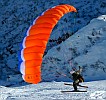





Data
|
SIZE |
NANO #10 |
NANO #12 |
NANO #13 |
NANO #14 |
|
FLAT AREA |
10
|
12
|
13
|
14
|
|
PROJECTED A. |
8.73
|
10.46
|
11.2
|
12.09
|
|
FLAT A.R. |
3.8
|
3.8
|
3.8
|
3.8
|
|
PROJECTED A.R. |
2.99
|
2.99
|
2.99
|
2.99
|
|
CELLS |
18
|
18
|
18
|
18
|
|
WEIGHT KG |
2.5
|
2.7
|
2.8
|
2.9
|
|
PILOT LEVEL /
WEIGHT |
Expert
|
Advanced
|
Beginner
45/75 kg
|
Beginner
75/100 kg
|
Manufacturers info
Speed Flying is a new winter flying sport created by paraglider pilots
and skydivers looking for a new sensation and to create a link between
gliding by ski and gliding through the air.
For a few years, pioneers have used skydiving parachutes or modified kites.
Linking the flight of a glider with the turn of your skis adds a new
dimension to the descent from a mountain! It’s an exhilarating sport which
will excite and fascinate both participants and spectators…
This new sport has taken the slope by storm, quickly attracting more and
more enthusiasts as the buzz of excitement sweeps across Europe! First in
France, where Speed Flying was born, but now also in Switzerland and Austria
with Italy and Germany not far behind.
Gin Gliders decided early on to be the first brand to create a wing
specially designed for Speed Flying.
That wing is ready, we call it: NANO.
NANO is a glider specifically adapted to the practice of this new sport.
Simple and easy to use, NANO is available in 4 sizes: 10m2, 12m2, 13m2 and
14m2. Pick your size according to weight and more importantly experience.
The smaller the glider the faster you go...
The 13m2 and 14 m2 are for light or heavy beginners and intermediates.
The 12 m2
is to be flown by very experienced pilots with a very good and
precise level of control.
The 10 m2 is dedicated to the best expert pilots only, and is currently only
for the GIN Team
Experts flying the 10m will be able fly at well over 100km/h!!!
Novices will be flying at more like 35-70km/h. These gliders have a trim
system to speed up or slow down flight.
They are very easy to launch, extremely solid in flight and responsive to
your input.
Speed Flying is an exhilarating experience that should be
practiced with
care and in a carefully chosen environment.
The Gin Nano is sold complete with glider, a convertible harness/rucksack
and carabiners.
Discover freedom with the Nano, the first Speed Flying glider created by GIN
!Video:
gin_speedflying.mpg - 22Mb |
Comments
The Nano was one of the first 2 Speedgliders (with the J/N
Hellracer) specifically marketed for this purposes.
Rumor
has it, that it is basically a copy of a PdF-Springo
(next chapter!). which again is said to be a copy of Stiletto (skydiving
canopy of 1995)
Gin will present a new Version of the Nano, (named sth like "Nano 07")
which will then have diagonal cells. This reduces the wings tendency
to "pump" and by that it will increase the performance. Still the 2 risers
will allow an exact adjustment of the glide-angle, so better performance
does not mean that you will now no longer be able to stay close to the
slopes.
I am a bit disappointed of Aerosport, the German distributor, because
they promised me for several weeks to send me a Nano and a Bullet for my
review for one of the biggest paragliding magazines and finally never did
so.
| Parachutes de France Springo |
| |
|
| Website: |
www.parachutes-de-france.com
|
| Sizes: |
4 Sizes, 10-15m² |
| Price: |
~1559 Euro (Link) |
|
Character: |
This wing is also a
skydiving canopy. This is the wing that started the new trend
making it's appearance in videos like "Ataka"! |
| |
|


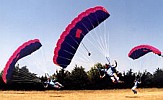
Data
|
Model |
Springo 110 |
Springo 120 |
Springo 140 |
Springo 160 |
|
Surface (m²) |
10,2m² |
11,1m² |
13m² |
14,9m² |
|
Technology |
9 boxes (2 tri-cell boxes) |
|
Scale (m) |
5,19 |
5,5 |
5,97 |
6,3 |
|
Maximum cord (m) |
2,06 |
2,18 |
2,37 |
2,5 |
|
Twist mini (m) |
1,41 |
1,49 |
1,62 |
1,71 |
|
Lengthening |
2,7 |
|
Suspending rods |
Spectra 750lbs |
|
Fabric |
Under-surface PF2500/Suction face ZP-00A |
|
Weight (kg) |
2,1 |
2,3 |
2,55 |
2,75 |
|
Pilot weight
min (kg) |
55 |
60 |
75 |
|
Pilot
weight
ideal
(kg) |
60 |
70 |
80 |
90 |
|
Pilot
weight
max (kg) |
65 |
80 |
95 |
110 |
Manufacturers info
from the website
|
http://www.parachutes-de-france.com/sources/html/clients/fr/produit_t/124.html
(bad translation)
|
The SPRINGO was drawn in the state of mind of the sports of slips modern
which are Surfing, WindSurf, the Surfing of snows. Beyond the sail it is
a whole philosophy: freedom to act, speed on trajectory, promptness of
rotation and superb control with the landing are the principal pleasures
which a SPRINGO offers.
Intended for the origin to meet requirements raised in term of
performances, the SPRINGO is the choice of a large population
parachutist thanks to the work carried out by our engineering and design
department in order to widen the possible speed range to the landing.
The SPRINGO offers such a flexibility that the low turns are not
absolutely necessary to produce "flares" long and planing. Between the
hands of a fairly trained parachutist, the SPRINGO will be soft and
flexible. Between the hands of a tested "skygod", it will be the source
of an intense pleasure.
Take pleasure with the SPRINGO. If you do not wish only high
performances, then the SPRINGO is for you. We did it as you wished it.
|
Personal Comments
.
| NZ-Aerosports Daedalus GLS & GLX |
| |
|
| Website: |
http://www.nzaerosports.com (GLS) |
| Sizes:
|
|
| Price:
|
2300 Euro (Link) |
|
Character: |
This wing comes from
the other side of the fence: The Skydivers. They are also
interested
in footlaunching and have designed these special wings for that.
Superfast but obviously
very collapse resistant. |
| |
|

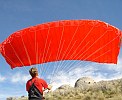

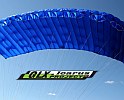


Data
| Model |
GLS (Sport) |
GLX (Extreme) |
| Flat area (m2) |
|
|
| Proj area (m2) |
|
|
| Proj AR (m) |
|
|
| Flat AR (m) |
|
|
| Flat span (m) |
|
|
| Proj span (m) |
|
|
| Root chord (m) |
|
|
| Cells |
|
|
| Weight (kg) |
|
|
Manufacturers info
Shortened from the website
|
http://www.nzaerosports.com/GLX.htm |
The Ground Launch Extreme is here! The GLX has been
designed for canopy pilots who just can't get enough of
swooping and enjoy paragliding or Bladerunning.
The history of ground launching: ...
The GLX development: ...
The new GLX:
The new GLX is a ground launching machine! After several
years of beta testing we have developed a parachute that is
easy to launch and a joy to fly down the mountain. The GLX
is completely cross braced with a hybrid nose section. The
center three cells of the canopy are open and the cells on
each side of the center are closed with opening similar to a
JVX. The GLX has no stabilizers, reinforced ribs and
utilizes Spinnaker cloth. Spinnaker material has been used
for years on ram air kites and paragliders. Spinnaker
material is crisp and thick allowing it to hold the
airfoil's shape better. Spinnaker material makes launching
easier and is more rigid during flight. The GLX comes
standard with two HMA or Vectran line sets. As an option,
pilots can get a continuous line set allowing broken lines
to be easily changed in the field without tools. A
continuous line set makes loosing a line during flight less
"stressful" since you have more attachment points between
you and the canopy. If your serious about ground launching
and want the most from your Bladerunning experience there is
only one choice. Ask anyone who has flown a GLX and they
will all tell you the same. See you at the launch point...
|
Personal Comments
I would love to see one of these wings in action!
The history described on the
page stating
they have done "several years of beta testing" sounds quite
promising in terms of experience.
It is hard to say where to sort this in between flying and riding!
|
